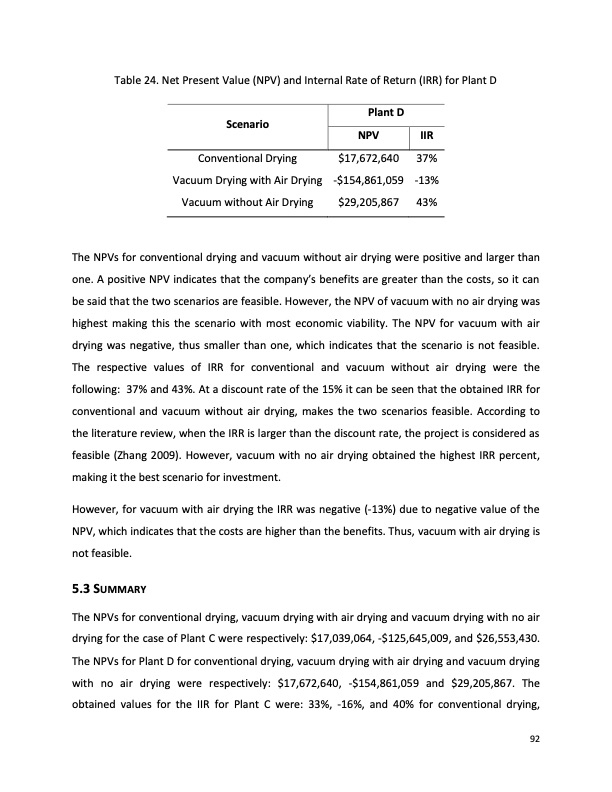
PDF Publication Title:
Text from PDF Page: 102
Table 24. Net Present Value (NPV) and Internal Rate of Return (IRR) for Plant D Scenario Conventional Drying Vacuum Drying with Air Drying Vacuum without Air Drying Plant D NPV IIR $17,672,640 37% -$154,861,059 -13% $29,205,867 43% The NPVs for conventional drying and vacuum without air drying were positive and larger than one. A positive NPV indicates that the company’s benefits are greater than the costs, so it can be said that the two scenarios are feasible. However, the NPV of vacuum with no air drying was highest making this the scenario with most economic viability. The NPV for vacuum with air drying was negative, thus smaller than one, which indicates that the scenario is not feasible. The respective values of IRR for conventional and vacuum without air drying were the following: 37% and 43%. At a discount rate of the 15% it can be seen that the obtained IRR for conventional and vacuum without air drying, makes the two scenarios feasible. According to the literature review, when the IRR is larger than the discount rate, the project is considered as feasible (Zhang 2009). However, vacuum with no air drying obtained the highest IRR percent, making it the best scenario for investment. However, for vacuum with air drying the IRR was negative (-13%) due to negative value of the NPV, which indicates that the costs are higher than the benefits. Thus, vacuum with air drying is not feasible. 5.3 SUMMARY The NPVs for conventional drying, vacuum drying with air drying and vacuum drying with no air drying for the case of Plant C were respectively: $17,039,064, -$125,645,009, and $26,553,430. The NPVs for Plant D for conventional drying, vacuum drying with air drying and vacuum drying with no air drying were respectively: $17,672,640, -$154,861,059 and $29,205,867. The obtained values for the IIR for Plant C were: 33%, -16%, and 40% for conventional drying, 92PDF Image | Impact of Vacuum-Drying on Efficiency of Hardwood Products

PDF Search Title:
Impact of Vacuum-Drying on Efficiency of Hardwood ProductsOriginal File Name Searched:
Brenes_Angulo_OM_T_2014.pdfDIY PDF Search: Google It | Yahoo | Bing
5,000 BF Shipping Container Lumber Dry Kiln For Quality Lumber The 5,000 BF container kiln consists of one 40 foot high-cube aluminum shipping container... More Info
Shipping Container Lumber Dry Kilns by Global Energy Global Energy designed and developed the container kiln back in 1991. The purpose is to give access to portable sawmill owners, furniture makers, and small business the value added profit of dry kiln lumber and quality hardwoods... More Info
Vacuum Kiln Conversion Kit for Lumber and Wood Dry Kilns Convert your existing conventional dry kiln into a fast drying vacuum kiln. Similar to vacuum bagging in the boat building and aircraft industry, we have come up with a proprietary process which allows you to build a very simple vacuum kiln at a fraction of the price, and without the intensive conventional metal chamber structure... More Info
Vacuum Pump Cart System for Bagging Clamping Wood Drying and more Vacuum Cart with 2HP Pump and Dual Pistons with multiple multiplex vacuum ports and liquid reservoir... More Info
Vacuum Bagging Basics Vacuum bagging is a method of clamping, which has traditionally been used in the composites industry, but can also be used for vacuum drying materials, including wood products... More Info
| CONTACT TEL: 608-238-6001 Email: greg@globalmicroturbine.com | RSS | AMP |